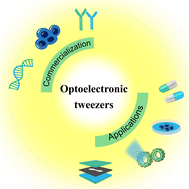Optoelectronic tweezers: a versatile toolbox for nano-/micro-manipulation
Abstract
The rapid development of micromanipulation technologies has opened exciting new opportunities for the actuation, selection and assembly of a variety of non-biological and biological nano/micro-objects for applications ranging from microfabrication, cell analysis, tissue engineering, biochemical sensing, to nano/micro-machines. To date, a variety of precise, flexible and high-throughput manipulation techniques have been developed based on different physical fields. Among them, optoelectronic tweezers (OET) is a state-of-art technique that combines light stimuli with electric field together by leveraging the photoconductive effect of semiconductor materials. Herein, the behavior of micro-objects can be directly controlled by inducing the change of electric fields on demand in an optical manner. Relying on this light-induced electrokinetic effect, OET offers tremendous advantages in micromanipulation such as programmability, flexibility, versatility, high-throughput and ease of integration with other characterization systems, thus showing impressive performance compared to those of many other manipulation techniques. A lot of research on OET have been reported in recent years and the technology has developed rapidly in various fields of science and engineering. This work provides a comprehensive review of the OET technology, including its working mechanisms, experimental setups, applications in non-biological and biological scenarios, technology commercialization and future perspectives.



 Please wait while we load your content...
Please wait while we load your content...